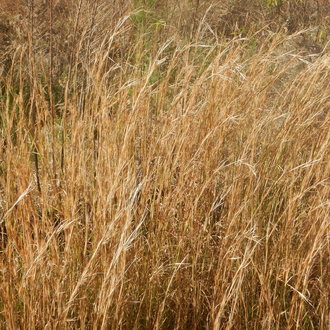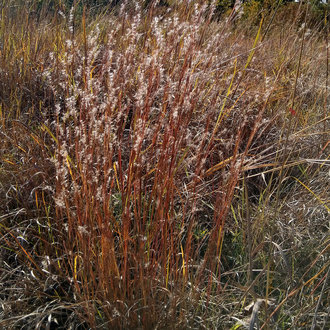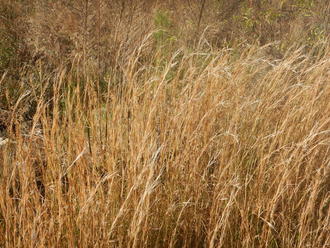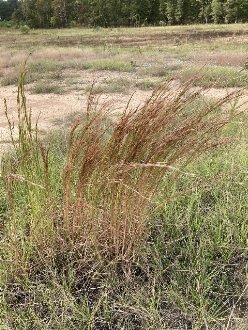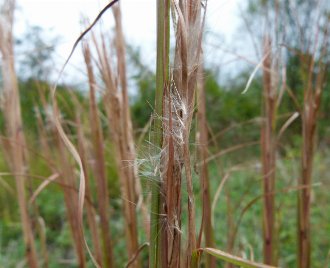Broomsedge Bluestem (Andropogon virginicus L.)
Also known as broomsedge, broom sedge.
↑Summary
A perennial grass native to eastern North America, an early colonizer of open, disturbed sites.
↑Range - Expand
| Legend | Color |
| Native | |
| Introduced | |
| Native or Not Present | |
| Introduced or Not Present |
This map is based on our research. We have checked its accuracy to Level 3 ecoregions. Although this plant occurs somewhere in each of these regions, it may only occur in a small part of some or all of them.
USDA reports this as native to California but all other sources we consulted, including Calflora and BONAP, consider it introduce there.
↑Similar Plants
↑Habitat
Found in a variety of open habitats, including grasslands, overgrazed pastures, and recently cleared forests. Also found in open woodlands. Frequent along roadsides and railroad tracks. Usually found in low-fertility soils, including sandy soil and eroded soils, but found in a variety of soil textures.
Forms extensive stands on sunny sites, but can exist as scattered individuals in sunny gaps in partly-shaded habitats. Only occupies an early successional stage on more fertile sites, but can persist long-term on sites with low soil nutrients.
Found in habitats that burn as frequently as annually, as well as those that do not burn. Fire tends to increase this species' abundance for a few years, as it prefers the open conditions that result after a fire.
The effect of humans on this species is complex: fire suppression has eliminated it from many habitats, but it is often the dominant grass along railroad tracks and in general humans have created many habitats where it thrives.
↑Life Cycle
Broomsedge is a warm-season, perennial bunchgrass.
Seeds germinate in the spring, following a period of cold dormancy, in exposed soil. Seedling germination and survival is high in sufficiently sunny conditions. Seedlings grow about 5 inches in their first year, and do not usually bloom in their first year.
Plants often reach their full height in their second year, although occasionally they will grow slightly taller in their third year. Plants usually begin blooming in their second year. Individual clumps grow in size each year, sending up more stems, but plants do not spread far vegetatively.
Seed production is high, and seeds are wind-dispersed. Seeds are released gradually, with many staying on the plant well into winter.
At the end of the growing season, aboveground parts of the plant die and typically remain standing through the winter. New growth begins in winter or spring, in response to temperatures reaching 60-65°F (15-18°C).
Established plants are highly fire-resistant, and encourage fire. Dead stems are highly flammable and carry fire well; they can even burn in conditions of high (80-90%) relative humidity and high (20-25%) fuel moisture content. Dormant season fires generally do not effect this plant, and growing-season fires only top-kill it. Plants both resprout after a fire, and colonize recently-burned sites with their wind-dispersed seeds.
Individual plants are usually short-lived.
↑Faunal Associations
Small birds, including junco, field sparrows and tree sparrows, often eat seeds from the stems, but generally only turn to this plant when other food sources are unavailable. Mammals, both wild ones such as deer, buffalo, and cultivated ones such as cows, will occasionally browse the young foliage, but usually avoid it later in the season.
Numerous insects eat the foliage during the growing season, including leafhoppers, bugs, scale insects, thrips, leaf beetles, and the larvae of the cobweb skipper (Hesperia metea) and the Carolina Grasshopper (Dissosteira carolina). The persistent foliage also serves as important shelter for overwintering insects.
↑Notes
The common name of this species, "broomsedge", is misleading as this species is a grass (Poaceae family), not a sedge (Cyperaceae family.) Unfortunately, this name is widely used and there are no other widely used common names for this species, so we are stuck with it for now.
↑Links & External Resources
• Broomsedge Bluestem | Fire Effects Information System (FEIS) (About This Site)
• Andropogon virginicus (Broom Sedge) | Illinois Wildflowers (About This Site)
• Andropogon virginicus (Broomsedge Bluestem) | USDA PLANTS Database (About This Site)
• Andropogon virginicus | Go Botany (About This Site)
• Broomsedge Bluestem | iNaturalist (About This Site)
• Andropogon virginicus | Biota of North America Project (BONAP) (About This Site)
• Andropogon virginicus | NatureServe Explorer (About This Site)
• Andropogon virginicus | Flora of North America (About This Site)
• Broomsedge Bluestem | Maryland Biodiversity Project (About This Site)
• Andropogon virginicus L. var. virginicus (Broomsedge, Broomstraw, Sedge Grass, Sage Grass) | Digital Atlas of the Virginia Flora (About This Site)
• Andropogon virginicus L. var. decipiens C. Campbell (Deceptive Bluestem) | Digital Atlas of the Virginia Flora (About This Site)



